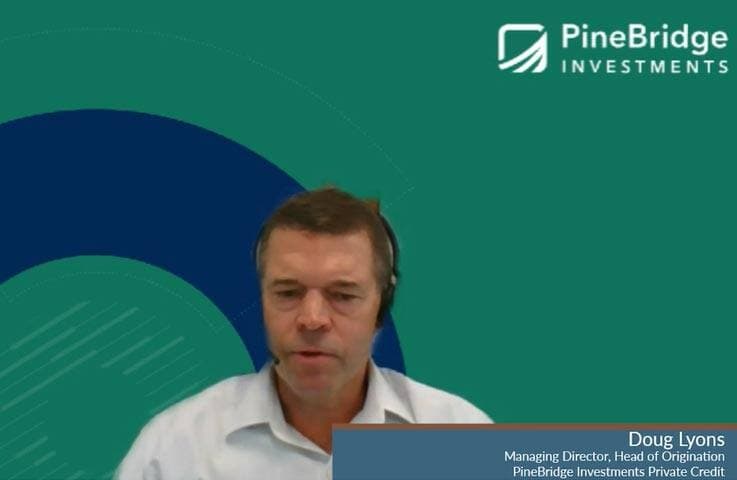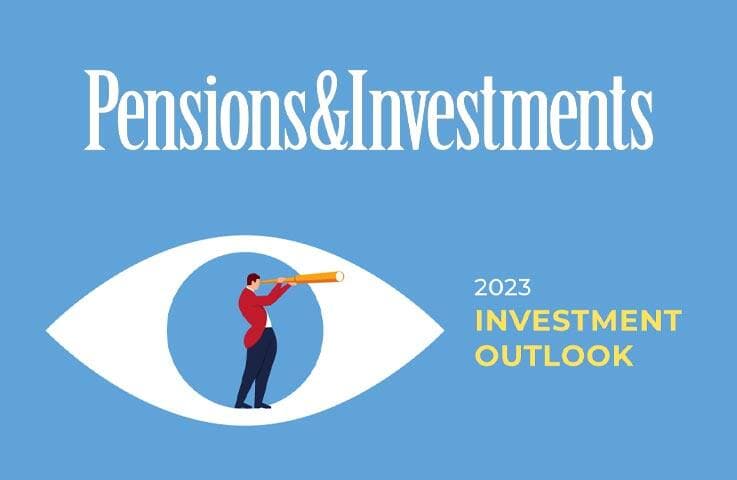How US Private Credit Can Endure Downturns

Doug Lyons
Managing Director, Head of Origination

Private credit capital-raising is on track for a robust year despite mounting global macro headwinds.
Rising interest rates can be a double-edged sword for US private credit, requiring experienced navigation to find the sweet spots in the market.
US private credit has historically delivered compelling returns with less downside risk than more liquid credit assets, making it a compelling diversifier in today’s markets.
Within private credit, we find the highest potential for better risk-adjusted returns in the US lower-middle-market segment, which has historically demonstrated lower credit loss and lower leverage than other segments.
Credit investments have become more attractive than ever as investors pursue assets that could capitalize on the Fed’s monetary tightening cycle. While rising rates are unfavorable to bond values, private credit’s floating rates move in tandem with the rate hikes, providing yield protection. Globally, close to US$100 billion in capital has been raised for private credit as of the second quarter this year, and the year-end total is forecast to rival 2021’s record of more than US$200 billion.1
North America Has the Largest Share of Private Capital Raised in Second-Quarter 2022

Source: Preqin as of 30 June 2022.
Surging inflation could put a damper on credit’s floating rate advantage as borrowers face higher debt servicing, labor, and other input costs, potentially putting pressure on their ability to repay loans. Still, we maintain that the US private credit market, the largest globally, offers attractive risk-adjusted performance vis-à-vis comparable credit strategies. We believe this should appeal to investors looking for above-high-yield returns on a lower risk budget. As every loan transaction is customized, the asset class’s correlation with public debt and equity remains low, making it an attractive diversifier. That said, we do recognize that relative to high yield and other fixed income assets, private credit is relatively less liquid as instruments are not traded in the secondary market and there is a place in portfolios for a range of credit opportunities. Accordingly within the private credit space, we focus on more resilient segments of the market and build portfolios based on a conservative risk-adjusted returns focused on downside protection and diversification.
US Private Debt Has Offered Better Risk-Adjusted Returns Than Comparable Assets

Source: Mercer, Thomson Reuters Datastream (ICE BofAML US High Yield Master II, S&P Leveraged Loan), and Burgiss (US Private Debt). Data is annualized to 30 June 2021. Past performance is not indicative of future results.
US private credit: a large and mature market
Private equity deals have been a key driver of the US private debt market as mergers and acquisitions (M&A) required financing. Over the past year, demand for loans went up alongside the pent-up M&A activity after a Covid-related cooldown in 2020. With a typical equity capitalization of 40%, PineBridge estimates the available private equity dry powder today implies approximately $110 billion in new senior loan demand and $90 billion of maturing middle-market loans (sponsored and unsponsored volume), which PineBridge estimates to be $200 billion in new loan demand.
Middle Market US Private Equity Fundraising Activity

Source: PitchBook, Q3 2021 US PE Middle Market Report. *as of 30 September 2021.
Middle Market US Private Equity Dry Powder

Source: PitchBook, Q3 2021 US PE Middle Market Report. *as of 30 September 2021.
The bulk of US private debt capital goes to direct lending. Unlike more liquid credit strategies, direct lending offers investors greater control over the parameters of their risk/reward by targeting specific segments, putting in robust covenants, and having the ability to work directly with the borrowers themselves to manage outcomes. This flexibility affords investors wider berth to navigate rising risks in global markets. For example, an institution may use a senior secured direct lending strategy in the lower-middle-market segment as a proxy for a capital preservation fixed income allocation.
We prefer the lower-middle-market segment of the US market, which represents one of the backbones of American enterprise. We remain sanguine on the resiliency of these companies, as highlighted by their performance over the global financial crisis (GFC) and the pandemic, while at the same time we remain active in our credit selection process and focused on sectors with historically low defaults, such as technology, health care, food, paper and packaging, and industrials.
While the private credit markets in Asia and Europe are growing and attracting large international providers, the US remains the most established, liquid, and diversified market. Last year, Preqin estimated that Asia-focused credit funds represented only about 5% of the global private credit capital-raising.2 Regulations are improving in Asia, which should help fuel demand, and over time we see the region becoming an attractive market, mirroring its long-term economic growth trajectory.
Low and mid-market borrowers: Between Main Street and the Fortune 500
Smaller businesses have historically contributed close to half of US economic activity.3 The lower-middle-market segment refers to companies that are bigger than the small and medium enterprises we typically associate with “Main Street” but smaller than large global corporations. They constitute a variety of high-value-adding enterprises poised to tap US secular trends for growth opportunities: from plant-based food manufacturing to oncology research to final-mile logistics. They generally have established track records and demonstrated ability to generate consistent cash flows. However, the size, business focus, and credit risk of these companies may be out of reach for banks because of tighter capital regulations after the GFC. This left a large imbalance of supply and demand of financing between the lower middle market and other areas of the market. With more accommodative terms, companies have found that direct lending from asset managers and other nonbank lenders can be more attuned to their needs.
While inflation does loom large among smaller companies’ concerns over the next 12 months, confidence remains buoyant, according to the second-quarter 2022 MetLife and US Chamber of Commerce Small Business Index. The index showed that smaller companies’ optimism on cash flows have softened, but two-thirds (66%) anticipate their revenue to increase over the next year.4 Similarly, a National Center for the Middle Market survey found that nearly four out of five middle-market companies reported revenue increases during the first half of 2022 from a year ago, with over half growing 10% or more. Most of those surveyed expect robust growth into 2023.5
Potential key advantages during downturns
Yet even if conditions rapidly deteriorate, US private debt has historically provided strong protective features that may help cushion its impact better than other comparable asset classes.
Lower credit loss
Being smaller doesn’t equate to being less creditworthy. The senior lower-middle-market credit segment has shown significantly lower credit loss than other segments, as well as high yield bonds and leveraged loans, over extended periods.
Average Credit Loss by Asset Class

Last 12 months as of 31 March 2022. Source: High Yield data: ICE BofA High Yield index; Leveraged Loans data: Credit Suisse Leveraged Loan Index; Upper MM data: Fitch; Lower MM Senior + Other data: Cliffwater Direct Lending Index (CDLI); LMM Senior Only data: Cliffwater Direct Lending Index- Senior Only (CDLI-S). For illustrative purposes only.
Annual Credit Loss by Asset Class

Last 12 months as of 31 March 2022. Source: High Yield data: ICE BofA High Yield index; Leveraged Loans data: Credit Suisse Leveraged Loan Index; Upper MM data: Fitch; Lower MM Senior + Other data: Cliffwater Direct Lending Index (CDLI); LMM Senior Only data: Cliffwater Direct Lending Index- Senior Only (CDLI-S). For illustrative purposes only.
Stronger loan covenants for this segment play a large role in managing credit loss by including certain financial conditions for companies to meet over the duration of the loan. For this sector, we focus on making senior secured first-lien loans to sponsor-backed companies seeking capital for acquisitions, leveraged buyouts, and recapitalizations. The average recovery rate for first-line loans stands at 76% for the period 2002-2021, according to Fitch.6
Lower leverage
Excessive leverage may limit the ability of companies to manage inflation and higher interest rates. However, this has not been the case in this segment, which has demonstrated lower average leverage of 4.7x since 2013, versus 5.8x for the upper middle market and 6.5x for broadly syndicated loans (BSLs).7
Yield premium
Returns from private credit are derived primarily from income. Middle-market direct lending has been priced at an average 204 bp premium over BSLs, with an average term loan yield of 7.3% since 2013. In contrast, upper-middle-market loans had an average 166 bp premium over BSLs with an average term loan yield of 6.9% for the same period.8
The quarter-on-quarter deal comparison below highlights the superior terms offered in the lower middle market than the upper middle market, with higher yields and deals priced at better multiples, although they have risen since the first quarter.
Upper vs. Lower Middle Market Direct Lending Terms

Source: Refinitiv LPC’s 2Q’22 Middle Market Sponsored Private Deal Analysis as of 20 July 2022. TL refers to term loan. *Loan volume includes revolvers, first- and second-lien term loans, unitranches, delayed draw term loans, mezzanine, and seller notes. ** First-lien spreads exclude unitranches; assumes 3-month Libor for Libor-based loans and 1-month Secured Overnight Financing Rate (SOFR) for SOFR-based loans in 1H22 yield calculations. Note: leverage, spread, and yield statistics exclude annual recurring revenue (ARR) deals.
Robust underwriting
While typically smaller deals, the underwriting for the lower-middle-market segment tends to be more robust and forms the backbone of risk mitigation. Transactions typically include one or more financial covenants and comprehensive agreements, with longer due diligence periods of eight to12 weeks. Other segments have shorter due diligence periods (one to six weeks) and are covenant lite, which could offer less recourse should problems arise.
As with other private asset classes, the manager’s performance may vary. Institutions seeking to take advantage of this opportunity may find that partnering with managers that have deep experience in sourcing deals, a robust underwriting process, and disciplined portfolio management, as well as a wide expert network, will be key to successfully navigating an evolving macro environment.
Footnotes
1 Source: Preqin as of 30 June 2022. 2 Bloomberg as of 6 April 2022. 3 Small Business Administration as of 30 January 2019. 4 Second-quarter 2022 MetLife and US Chamber of Commerce Small Business Index. 5 National Center for the Middle Market, “Mid-Year 2022 Middle Market Indicator,” https://www.middlemarketcenter.org/Media/Documents/MiddleMarketIndicators/2022-Q2/FullReport/NCMM_MMI_MID-YEAR_2022_WEB.pdf 6 Fitch Ratings as of 21 March 2022. 7 Refinitiv LPC, Fourth-quarter 2021 Middle Market Sponsored Private Deal Analysis as of 31 December 2021. Leverage represents total leverage by market segment. LMM includes club MM (all deals), UMM includes Institutional Middle Market, and BSL includes Large Corporate. 8 Source: Refinitiv LPC, Fourth-quarter 2021 Middle Market Sponsored Private Deal Analysis as of 31 December 2021. Yield represents first-lien term loan yields only. LMM includes direct lenders only, UMM includes banks and direct lenders, and BSL includes Large Corporate.
Disclosure
Investing involves risk, including possible loss of principal. The information presented herein is for illustrative purposes only and should not be considered reflective of any particular security, strategy, or investment product. It represents a general assessment of the markets at a specific time and is not a guarantee of future performance results or market movement. This material does not constitute investment, financial, legal, tax, or other advice; investment research or a product of any research department; an offer to sell, or the solicitation of an offer to purchase any security or interest in a fund; or a recommendation for any investment product or strategy. PineBridge Investments is not soliciting or recommending any action based on information in this document. Any opinions, projections, or forward-looking statements expressed herein are solely those of the author, may differ from the views or opinions expressed by other areas of PineBridge Investments, and are only for general informational purposes as of the date indicated. Views may be based on third-party data that has not been independently verified. PineBridge Investments does not approve of or endorse any republication of this material. You are solely responsible for deciding whether any investment product or strategy is appropriate for you based upon your investment goals, financial situation and tolerance for risk.



